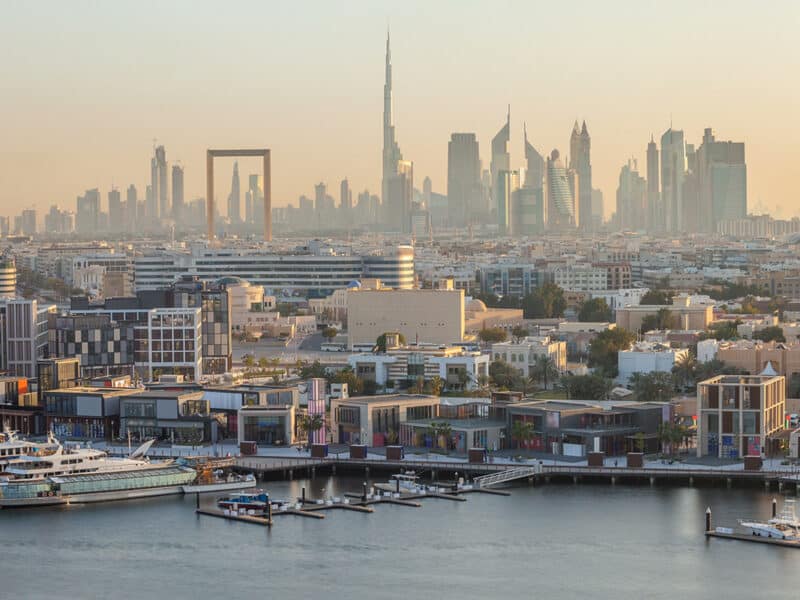The rise of South Korean consumer electronics giant Samsung to the forefront of the consumer electronics industry in the Middle East has been impressively swift.
Having established its regional headquarters in Dubai in 1995, the company secured the number two position behind archrival and compatriot LG Electronics in the regional consumer electronics sector in 2005, with revenues exceeding US$2.2 billion.
The president and chief executive officer of Samsung Middle East and Africa, Chi Won Suh, recently unveiled a strategy aimed at doubling Samsung’s combined revenues generated in the region to US$5 billion by 2010.
Key to this strategy is the continued development of the company’s range of high-end mobile handsets and digital media products led by its Bordeaux-branded LCD television portfolio.
The ultimate responsibility for delivering results in the latter sector lies with Je Hyoung Park, the president of Samsung Gulf Electronics.
Despite being overshadowed in recent years by LG in terms of regional success, Park remains confident that Samsung will eventually surpass its archrival and claim the number one position in the marketplace.
Park was appointed to the position of president in 2003 and has played an instrumental role in driving the company’s expansion in the interim. Based in Dubai, Park oversees control of 12 regional Samsung offices scattered across the Middle East and Africa.
While he sees huge commercial potential for Samsung’s business in the emerging markets of both regions, the GCC countries remain the company’s core commercial priorities at present.
“The Gulf consumer markets have been remarkably transformed over the past decade, and are continuing to evolve,” he says. “The GCC continues to provide major commercial opportunities for our business.”
Park says the company maintains a flexible approach to dealing with individual markets across the region in terms of channel distribution.
“The channel dynamics and the strategies we employ also vary from consumer electronics to IT, to mobile handsets and accessories,” he says.
“We work with different distributors catering to each market, depending on their speciality. We also take into consideration population size and the growth potential of a particular country’s consumer market.
“Depending on these variables, we may work with up to three distributors involved in a particular subsector of the market.
“We don’t maintain any exclusive distributor relationships, mainly because we offer such a diverse range of consumer products. However, we are willing to take a flexible approach depending on certain situations. For example, if a distributor is performing well in a particular market, we do not actively pursue any distribution agreements that may impact their business.
“We also employ agents to manage our marketing activities in certain countries. If a particular market is performing well under this arrangement, we do not interfere in the market.”
Park believes the increased convergence of consumer electronics and IT technology provides a major boon for companies that maintain a presence in both sectors such as Samsung.
He says the company is intensifying its research and development efforts in a bid to develop products that leverage the best aspects of both technologies for the consumer sector.
“Many people still view the IT and consumer electronics sectors as being separate, but the rate of development of new networked products mean this situation is rapidly changing,” he says.
Park claims this development is also altering the dynamics of the channel distribution sector, with many distributors and retailers embracing technology that blurs the line between the IT and consumer electronics sectors.
“In five years, there will no longer be a clear distinction between IT and audio-visual (AV) products in the marketplace,” he claims. “LCD monitors will be used for a range of applications, from viewing content downloaded from the internet to watching a film. It’s the same situation with home theatre – consumers will increasingly demand access to a range of multimedia applications including the internet from their TVs.”
Park says a range of consumer electronics subsectors are being impacted by convergence, including product categories such as MP3 players.
“There is a certain amount of confusion in the industry as to whether an MP3 player is an IT product or an AV product,” he says. “Many traditional IT vendors are selling MP3 players, mobile phones and digital cameras, which is further confusing the situation.
“Our mobile phone division, for example, recently released a 10-megapixel camera phone. This model has attracted considerable interest from traditional camera retailers looking to stock the product, which shows how the lines have blurred as a result of convergence.”
Park believes the key difference between the IT and AV markets can be seen in terms of profit margins.
“The margins in the IT channel are not as great when compared to mall-based AV retailing, which leaves the former at a disadvantage in terms of establishing a presence in a retail mall,” he says.“Rising rental costs are severely impacting the market overall in this region in terms of margins,” he continues.
“Power retailers are increasingly looking to establish standalone stores to avoid the high costs associated with mall-based retailing.”
Samsung recently provided an insight into its future product development strategy at the IFA 2006 consumer electronics show in Berlin, an event that Park attended.
He says the products that were showcased at IFA will form the cornerstone of the company’s strategy in the Middle East for wresting the top position in the consumer electronics sector from LG.
“The emergence of high definition-compatible technologies such as our LCD TV range and Blu-ray DVD players will transform the consumer sector in the Middle East,” he says.
“Flat panel TVs are already having a huge impact on the television receiver market, particularly in the GCC.
This trend will eventually impact other markets in the region, particularly as LCD panel prices continue to fall.”
Samsung is also investing heavily in mobile TV technologies based on new digital television standards, such as those developed by the European broadcasting body DVB. The company recently debuted the world’s largest portable digital television receiver based on the DVB’s terrestrial digital multimedia broadcasting (DMB) standard. With an LCD screen size of 10-inches, the unit is pitched directly at early adoption markets.
Samsung recently received European Imaging and Sound Awards (EISAs) for four IFA debutantes – its LCD TV with LED backlight, Q1 ultra-portable Mediabook PC, mini printer, and NV-10 compact digital camera.
Park says such recognition is tribute to Samsung’s commitment to product innovation and differentiation – two key elements in its commercial strategy.
He adds that such innovation has led to the company focusing on developing all-encompassing home networking solutions, linking networked appliances and home automation facilities via a central server in the home.
“Samsung’s Home Vita home networking application portfolio has proven very popular in South Korea and certain countries in Europe,” he says. “The technology provides homeowners access to a range of functionalities, including remote control of appliances, wireless multimedia networking and home security applications.
“We’ve successfully conducted a ‘community trial’ of the technology involving 3,000 households in Seoul.
We’re also involved in a similar initiative in Moscow.” Closer to home, Samsung combined with UAE telecommunications provider Etisalat earlier this year to showcase a working demonstration of the technology in Abu Dhabi.
Park says the demonstration paid huge commercial dividends, with Samsung attracting interest from a host of property developers, culminating in the company securing a major deal with those involved in the US$3.3 billion development of Abu Dhabi’s Saadiyat Island.
While reluctant to confirm details, Park did explain that the deal called for the development of a “working community” of properties entirely networked using Home Vita technology. He says the development should be ready for launch within three years.
“Today, consumers can use their PCs to relay multimedia content remotely to monitors throughout their homes,” he says.
“Smart home technology will change the way people live and interact with technology in their homes. The vast majority of consumer electronics and household appliance products can be wirelessly connected and can be improved as a result of this technology.”
Park believes the GCC is slowly approaching Western markets in terms of the pace of new technology launches, a fact he attributes to the growing affluence and importance of the region’s consumer markets to foreign consumer electronics vendors.
“In the Middle East and Africa, the GCC sets the pace in terms of new product releases,” he says. “The UAE is fast catching up to our European markets in terms of product rollout timings. However, other countries in the GCC still lag behind.
“I would estimate that the current time delay between new product launches in Europe and Dubai are anywhere up to 12 months, closely followed by other markets in the Gulf. But this situation is changing rapidly.
The products we are selling here and the European market are the same.
“However market demands vary. In Europe, 100% of all monitors we sell are LCD, but in Dubai the ratio is 70:30, while in Egypt, LCDs only account for 10% of our entire monitor display sales.”
Park remains an outspoken critic of the current measures designed to tackle counterfeit goods in the Middle East, describing them as “inadequate” and out of date.
“Counterfeit goods remain a major issue impacting the consumer electronics channel, particularly in the GCC,” he says. “In the Deira area of Dubai, there are a huge number of stores selling counterfeit mobile phone accessories. While the Dubai authorities don’t take the matter seriously, this trade impacts every company involved in the mobile business.
“Counterfeit goods manufacturers and resellers are undercutting us across the board by leveraging our brand equity and selling their products for less than average wholesale prices.
“Our distributors continuously complain about these issues. While there are some random checks by authorities – maybe once or twice a year – these products continue to be sold every day.
“The industry and authorities need to work together to eradicate this trade, because it has a severe impact on the legitimate distribution and sale of consumer electronics goods in the region.”
The emergence of high definition-compatible technologies such as our LCD TV range and Blu-ray DVD players will transform the consumer sector in the Middle East. Je-Hyoung Park
PRESIDENT & CEO • Je Hyoung Park.
REGIONAL HEADQUARTERS • Dubai, UAE.
REGIONAL OFFICES • Six in the Middle East and six in Africa.
2005 MEA TURNOVER • US$2.8 billion (incorporating Africa).
BIGGEST SELLING PRODUCT LINES • Bordeaux LCD and plasma
TVs, high-end mobile handsets.
FAST FACT • Samsung is aiming to double its turnover in the
Middle East and Africa to US$5 billion by 2010.








